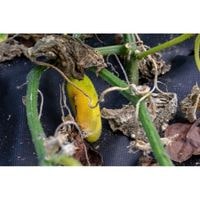Why are my Cucumbers Yellow. These are usually quite productive and easy to grow, but if one fails, you may wonder if your green thumb has gone brown.
While it’s normal for cucumbers to turn yellow, sometimes they develop but fail to turn green or start out green only to become orange or yellow.
Yellowing cucumbers might signal a problem but they are sometimes a natural occurrence.
Knowing the difference is key, and then following some simple steps in order to address any problems that may follow will be vital in keeping them from happening again down the line.
Why are my Cucumbers Yellow

When cucumbers become overripe, their green coloring produced from chlorophyll can begin to fade, resulting in a yellowing pigment. Yellow cucumbers are generally not fit for consumption and thus they are often discarded.
This might also occur as a result of a virus. As a plant grows, it needs more nutrients especially nitrogen so if you see yellowing at the top of cucumber or other plants in your garden.
It’s likely because there is an imbalance in the soil and therefore the gardener should add more organic material like compost to restore healthy soil conditions.
Over Watering & Fertilizing
The cucumber’s shallow roots demand consistent moisture, but keeping them too wet can also be problematic.
To keep your cucumbers adequately hydrated without letting them get washed away, water the plants weekly during long periods of dryness, or whenever you notice the top inch of soil feeling dry to the touch.
While cucumbers are set back when it rains too much due to their shallow root system, adequate nutrition is an important factor in preventing them from turning yellow and staying small rather than reaching their full size.
To prevent this from occurring, mix 1 cup of a 10-10-10 fertilizer into each 10-foot row at planting time.
When the young vines reach 1 foot in length, mix 1 tablespoon of fertilizer into the soil beside each plant intermittently as needed up until harvest time.
Overripe
Cucumbers don’t spoil easily. They’re happy to stay on the vine or in your refrigerator for a very long time but you must start noticing yellow spots so that they can be thrown away once they start rotting.
Diseases of cucumbers

Cucumber mosaic is an incurable disease that causes yellow and white mottling to occur on leaves, stunted cucumbers, and yellow or white mottling.
Plants that have this disease must be removed immediately and destroyed, as the disease is readily spread by aphids and cucumber beetles.
The best way to avoid being hit with this illness is to cover the plants with floating row covers in early spring to protect them from insect infestation.
You’ll need to uncover them again before summertime as they can interfere with pollination. However, you should take precautions against diseases like Cucumber Mosaic Virus in order to help ensure a healthy crop at harvest season.
Spay your plants with pesticides on still days that are free of strong winds. Repeat the process every two weeks until further notice if any insects will attack your plants and try to cause harm.
Unbalanced Nutrition
When compared to their tomato brethren, cucumbers seem to need more of just about everything.
Whether it be fertilizer or other nutrients like nitrogen, potassium, and phosphorus in the NPK ratio 1:1:3, you have to water your cucumber plants pretty heavily when they’re at a smaller size.
How do you fix yellow cucumbers?
If a cucumber plant does not grow to the expected size for the variety, it may be deficient in nutrients.
To prevent this problem, use a balanced fertilizer when planting. Organic matter can also be added to the soil and more fertilizing is done after bloom time throughout the growing season.
Can I eat my yellow cucumbers?
Don’t let cucumbers turn yellow! A yellow cucumber is usually over-ripe or otherwise undesirable for either cooking, pickling, or eating.
Fruits and veggies that are sick can also result in a greenish to pale yellow color – so don’t be fooled by their appearance.
Why are my Cucumbers Yellow
Related Guides
